Diving right into the world of birds, I’d like to introduce you to a charming and colorful creature – the Brown-Headed Barbet. This fascinating bird, primarily found in India and Sri Lanka, is known for its distinctive call that echoes through the forests it calls home.
With a green body contrasted by a brown head and streaks of red near its beak, this bird isn’t just musical and visually striking.
For those who haven’t had the pleasure of meeting this avian marvel yet, let me give you a glimpse into its life. The Brown-Headed Barbet thrives in subtropical or tropical moist lowland forests where they can freely scavenge for their favorite fruits and insects.
They’re famous for their unique nesting habits; these clever birds carve holes in trees to nest, showcasing their resourcefulness.
While they may not be as renowned as some other species, it’s high time we spotlight these intriguing creatures.
After all, understanding our feathered friends like the Brown-Headed Barbet can give us valuable insights into biodiversity and nature’s intricate systems.
Habitat and Distribution of the Brown-Headed Barbet
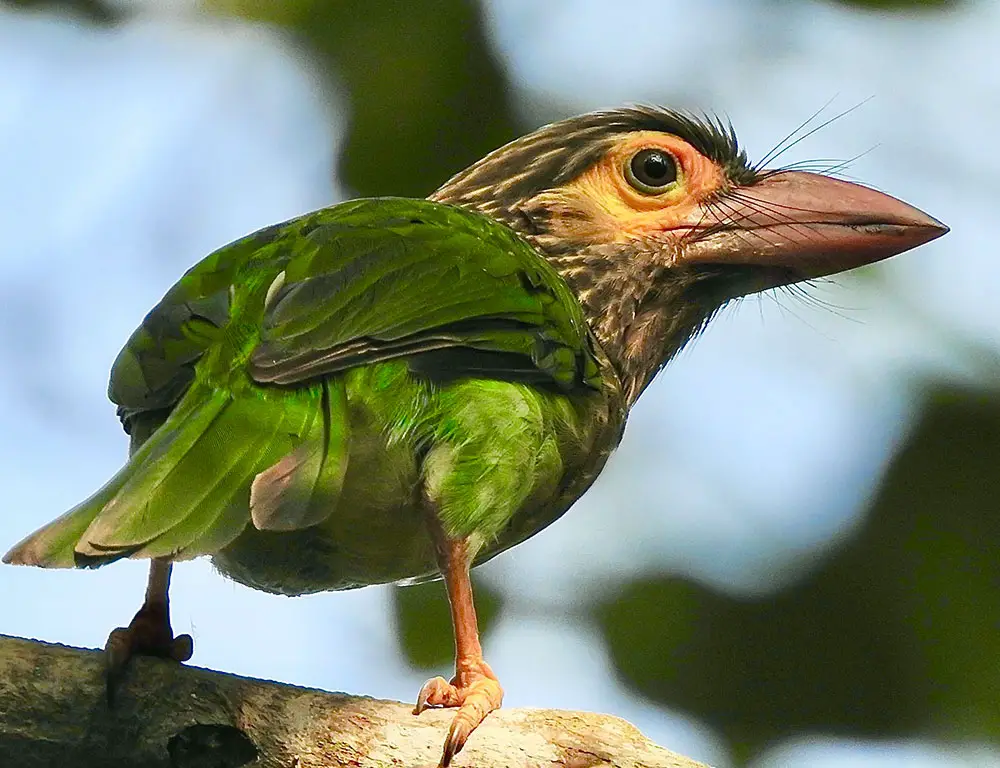
The Brown-Headed Barbet, known scientifically as Psilopogon zeylanicus, is a fascinating bird species with diverse habitat and distribution patterns across the Indian subcontinent.
Let’s delve deeper into its habitat and distribution:
Geographical Range
The primary range of the Brown-Headed Barbet includes India, Bangladesh, Nepal, Sri Lanka, and certain parts of Pakistan. Within these countries, they are distributed unevenly, with varying levels of presence.
Preference for Urban Areas
Despite being forest-dwelling birds, Brown-Headed Barbets have displayed an exciting adaptability to urban environments. They can be commonly found in city gardens and parks, showcasing their ability to coexist with human settlements.
Natural Habitats
While adaptable to urban areas, Brown-Headed Barbets primarily thrive in deciduous forests and heavy woodlands. These environments provide them with suitable nesting sites, food sources, and shelter.
Altitude Tolerance
Brown-Headed Barbets inhabit altitudes of up to 1300 meters above sea level. However, they are rarely observed at higher elevations, indicating a preference for lower altitudes.
Non-Migratory Behavior
Unlike some bird species, Brown-Headed Barbets are non-migratory. They maintain residency in their chosen territories throughout the year, which may include both rural and urban areas within their range.
Distribution by Country
The distribution of Brown-Headed Barbets within the mentioned countries varies:
- India: Widespread presence
- Bangladesh: Common
- Nepal: Frequent
- Sri Lanka: Regular
- Pakistan (southern regions): Occasional
Physical Characteristics of the Brown-Headed Barbet
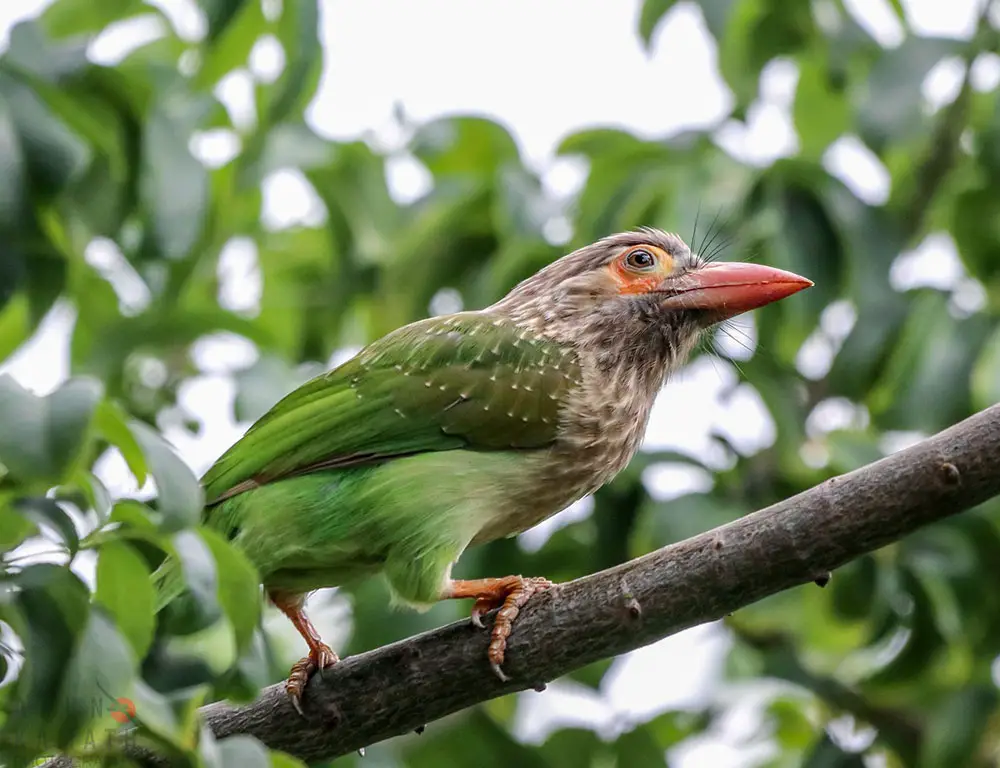
The Brown-Headed Barbet possesses a striking array of physical characteristics contributing to its distinctive appearance and ecological niche.
Let’s delve deeper into these features:
Size
With a compact body size, the Brown-Headed Barbet typically measures around 27 cm in length. While not large compared to other bird species, its size is well-suited for its habitat and lifestyle.
Head & Neck Color
As its name suggests, the most notable feature of the Brown-Headed Barbet is its brown head and neck. This distinctive coloring sets it apart and aids in identification.
Body Color
Contrasting with its brown head, the body of the Brown-Headed Barbet exhibits shades of green. This green coloration helps it blend into the lush foliage of its woodland habitat, providing camouflage from predators and prey alike.
Beak Structure
The Brown-Headed Barbet’s beak is a remarkable adaptation for its feeding habits. It is thick, strong, and uniquely streaked with hues of yellow and blue-grey. This robust beak is well-suited for consuming fruits and insects and excavating nest holes in tree trunks.
Wing Characteristics
Examining the wings of the Brown-Headed Barbet reveals short yet rounded formations. These wings are characteristic of Barbets and are adapted for agile flight, enabling the bird to maneuver swiftly through dense foliage in search of food and suitable nesting sites.
Diet and Feeding Habits of the Brown-Headed Barbet
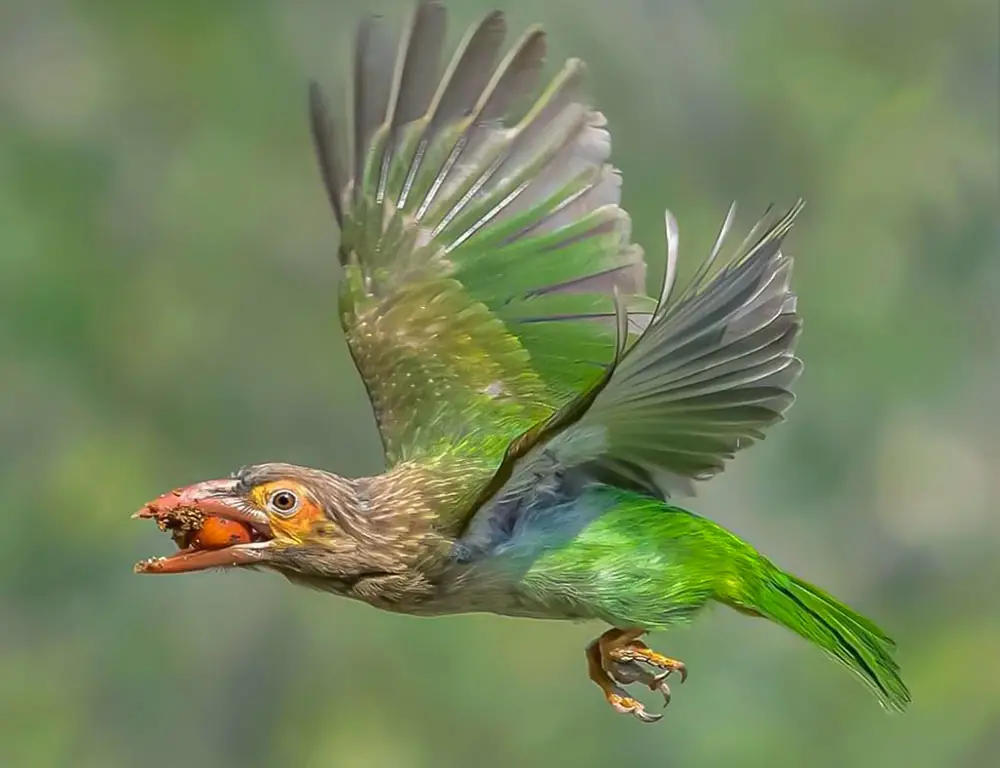
The Brown-Headed Barbet’s dietary habits are fascinating and reflect its adaptability to various food sources.
Let’s delve further into its diet and feeding habits:
Omnivorous Diet
Like many other barbets, the Brown-Headed Barbet is an omnivore, consuming plant and animal matter. This flexibility allows it to exploit various food sources depending on availability and season.
Preference for Fruits, Especially Figs
Fruits comprise a significant portion of the Brown-Headed Barbet’s diet, with figs being a particular favorite. These birds have a notable preference for figs and can consume large quantities of this fruit, especially during fig season.
Figs provide a rich source of nutrients and energy for the barbets.
Feeding on Insects, Especially During Breeding Season
While fruits are a staple food source, Brown-Headed Barbets also feed on insects, particularly during the breeding season when the demand for protein increases for themselves or their offspring.
They are skilled insect hunters capable of precisely snatching beetles and caterpillars.
Unique Feeding Style
Brown-Headed Barbets have a distinct feeding style unlike other bird species that peck at their food. They use their strong beaks to bite off pieces of food, which they then swallow whole.
This unique approach to feeding sets them apart and may be an adaptation to their preferred food items, such as fruits and insects.
Reproduction and Nesting Behavior of the Brown-Headed Barbet
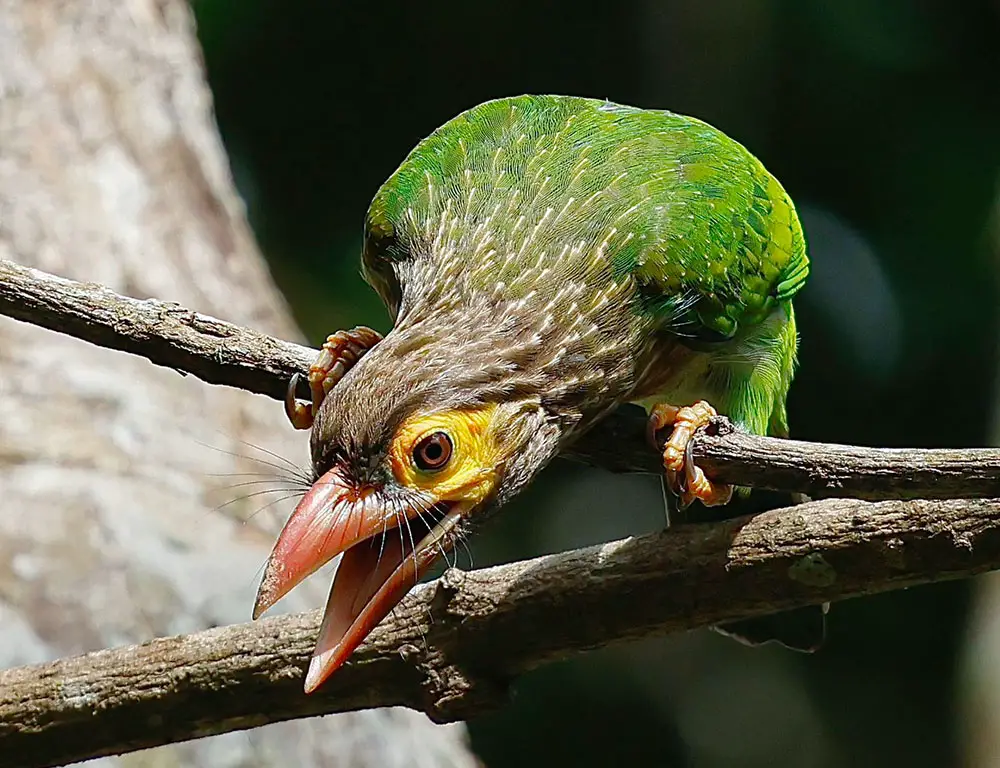
The reproduction and nesting behavior of the Brown-Headed Barbet indeed showcases fascinating adaptations and social dynamics.
Let’s explore these aspects in more detail:
Breeding Season
Brown-Headed Barbets typically breed between March and July, aligning with the onset of the monsoon season in their native habitats. This timing ensures that their young have access to abundant food sources and favorable weather conditions for survival.
Cavity Nesters
Unlike many other bird species, Brown-Headed Barbets are cavity nesters. They prefer to create their nests within tree trunks or branches, utilizing their strong beaks to chisel out wood and create a comfortable cavity for laying eggs and raising their young.
Egg Laying and Incubation
A female Brown-Headed Barbet typically lays between 2 to 4 white eggs per brood. Both parents participate in the incubation process, taking turns to keep the eggs warm throughout about 14 to 20 days until they hatch into young chicks.
Parental Care
Once the eggs hatch, parental care continues as the mother and father feed and care for the fledglings for approximately 30 days until they are ready to leave the nest.
This shared responsibility highlights the strong bond and cooperative behavior exhibited by Brown-Headed Barbet pairs.
Social Structure
Interestingly, Brown-Headed Barbets often live in small communities where multiple pairs may occupy adjacent cavities in the same tree.
This communal nesting behavior provides opportunities for social interactions, and offers added protection against predators.
Conservation Status of the Brown-Headed Barbet
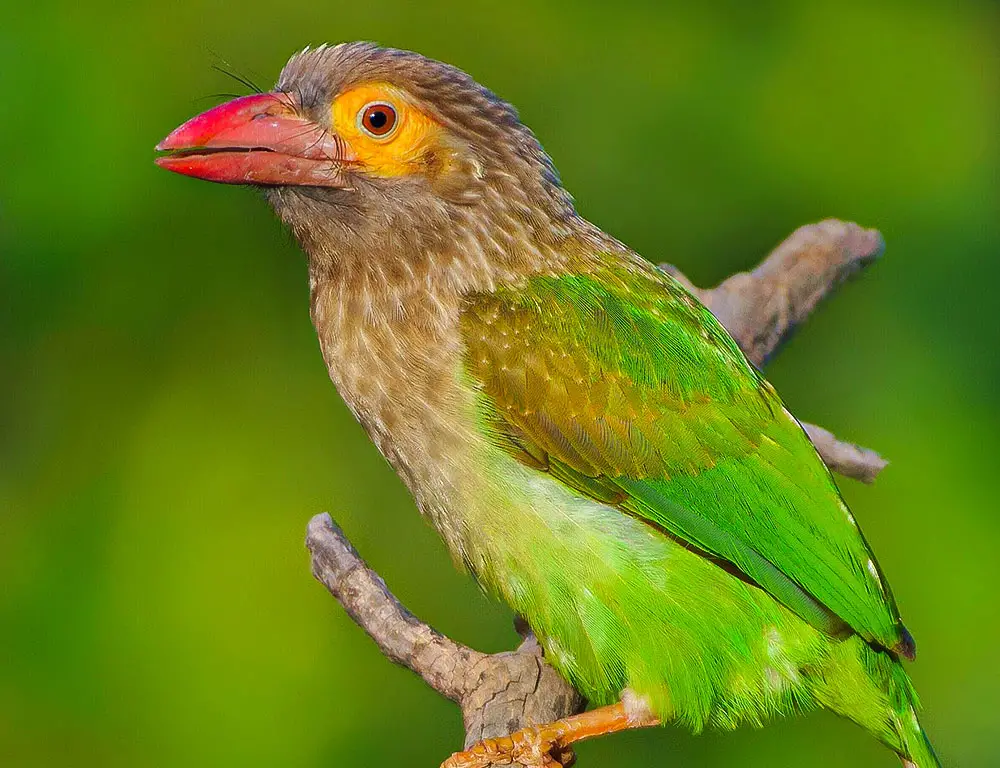
The Brown-Headed Barbet currently holds a conservation status of “Least Concern” according to the International Union for Conservation of Nature (IUCN).
Despite this classification, there are significant challenges and threats to their population that warrant attention and conservation efforts:
- Habitat Loss: One of the primary threats to the Brown-Headed Barbet is habitat loss due to deforestation and land conversion for agriculture and urban development. As forest and woodland areas shrink, the available habitat for these birds diminishes, potentially impacting their populations.
- Climate Change: Climate change poses another significant threat to the Brown-Headed Barbet and its habitat. Temperature and rainfall patterns can alter vegetation dynamics and disrupt food availability, nesting sites, and other crucial aspects of their ecology.
While the specific impacts of climate change on this species are still being studied, it represents a long-term threat to their survival.
To ensure the continued well-being of the Brown-Headed Barbet and other wildlife, conservation efforts should focus on:
- Preserving old-growth trees and maintaining suitable nesting sites within forests and woodlands.
- Implementing measures to limit deforestation and land conversion, such as sustainable forestry practices and protected area management.
- Incorporating green spaces and urban parks into urban planning to provide additional habitat and foraging opportunities for urban-dwelling Brown-Headed Barbets.
Conclusion
After a deep dive into the world of Brown-Headed Barbets, it’s clear that these birds are truly extraordinary. They’re not just birds; they offer more than what meets the eye.
Their unique nesting habits alone speak volumes about their adaptability. Using their strong beaks to drill holes in trees for nesting purposes shows impressive resourcefulness and resilience.
Here’s a quick roundup:
- Strong beak used as a tool
- Adaptable nesting habits
- Resilience in diverse environments
But it doesn’t stop at nesting habits. The diet of the Brown-Headed Barbet is another fascinating aspect, with fruit being their primary source of nutrition. However, they don’t shy away from adding variety by including insects and other small creatures when available.
The call of the Brown-Headed Barbet is distinct and can be recognized even in crowded, noisy environments. Their repetitive ‘Kutrook… Kutrook…’ sound resonates within their habitats, making them stand out among many bird species.
Most importantly, though, I’ve learned that understanding one species—like the Brown-Headed Barbet—can lead us to appreciate our planet’s ecosystem’s broader beauty and complexity.
It’s a reminder that we share this earth with countless other species trying to survive and thrive in their way—and we have much to learn from them.
So next time you’re out on a bird-watching adventure or if you happen upon a strange drilling sound emanating from a tree nearby, remember: It might just be our fascinating friend—the Brown-Headed Barbet—going about its day-to-day life.